Aggregate Livestock and Poultry production in Region I posted a 5.96 percent gain in 1st semester 2018. Improvements in production were noted in livestock subsector by 2.67 percent and poultry subsector by 10.59 percent.

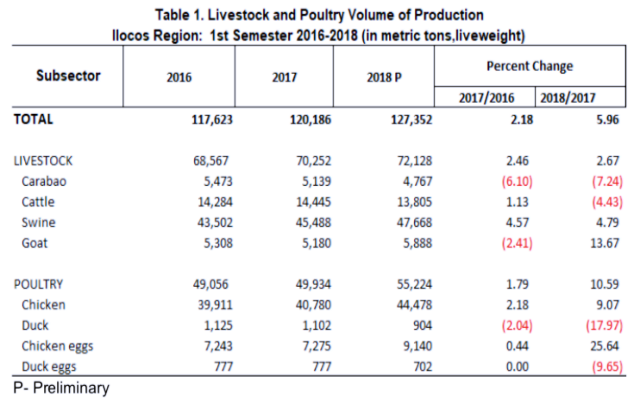
By animal and product type, swine and chicken production were the major source of the overall production growth with shares of 37.43 percent and 34.93 percent respectively.
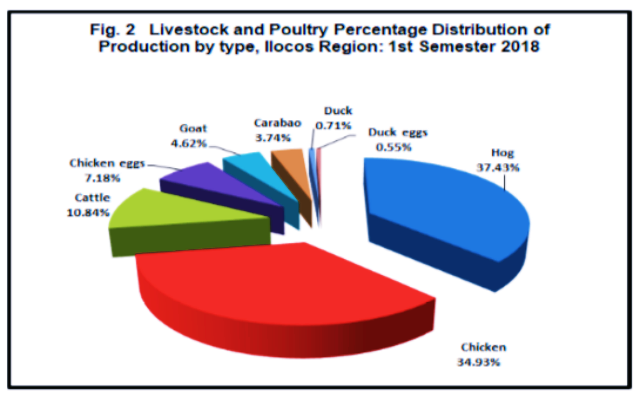
CARABAO
Carabao production in 1st semester 2018 was 4,767 metric tons liveweight. It registered a 7.24 percent reduction in output compared to 2017 of same period.
Total carabao inventory in Region I as of January 1, 2018 was estimated at 169,592 heads. It was 2.26 percent higher than last year’s headcount of 165,850 heads. More stocks were kept in backyard farms, especially caracows for breeding purposes. Moreover, this can also be attributed to the dispersal and continuous Artificial Insemination of the Provincial Government of Ilocos Sur and DA-RFOI in backyard farms. Backyard farms accounted 99.73 percent of the total carabao population while the remaining 0.27 percent were accounted in commercial farms.
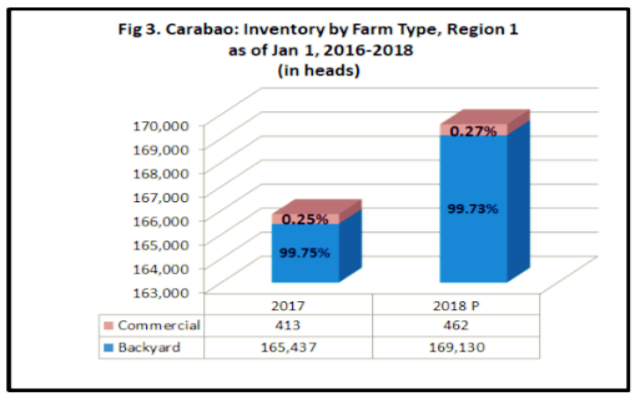
CATTLE
The region’s production on cattle was 13,805 metric tons liveweight. This was an output reduction of 4.43 percent compared to last year’s level of 14,445 metric tons.
The total headcount of cattle as of January 1, 2018 was 299,111 heads. This was lower by 0.40 percent as compared to the same period last year. About 99.12 percent of the total inventory were in the backyard, while the remaining 0.88 percent were in the commercial farms.

SWINE
Swine or hog production was estimated at 47,668 metric tons liveweight this 1st semester of 2018. It is equivalent to 4.79 percent gain in output compared to same period of 2017.
Total inventory of swine as of January 1, 2018 was 599,143 heads, higher by 3.80 percent than last year. Out of this total inventory, 78.71 percent were in backyard farms, while 21.29 percent were in commercial farms. The number of swine on both backyard and commercial farms grew by 1.17 percent and 14.80 percent, respectively. This can be attributed to the dispersal of native pigs by government agencies to backyard raisers and 4Ps beneficiaries as a form of livelihood. Moreover, it was noted that there were additional or expansion of commercial farms in La Union and Ilocos Sur.
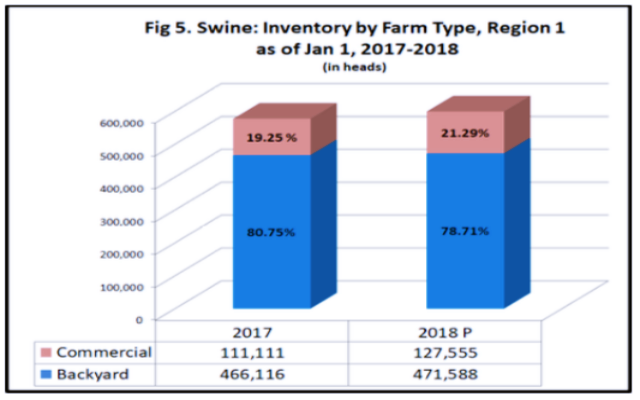
GOAT
Goat also gained in output by 13.67 percent over last year’s level of 5,180 metric tons liveweight. There were more stocks available for slaughter and sold live in backyard farms especially during the Palarong Pambansa and Batang Pinoy held in Ilocos Sur and barangay election related celebrations in May 2018 in all provinces.
The number of goat in the region in backyard farms as of January 1, 2018 was 450,299 heads, posted an increase of 8.60 percent as compared to same period last year. This contributed about 98.89 percent of the total goat inventory of the region. The commercial farms contributed about 1.12 percent of the total goat inventory. The number of heads in commercial farms declined by 2.52 percent.
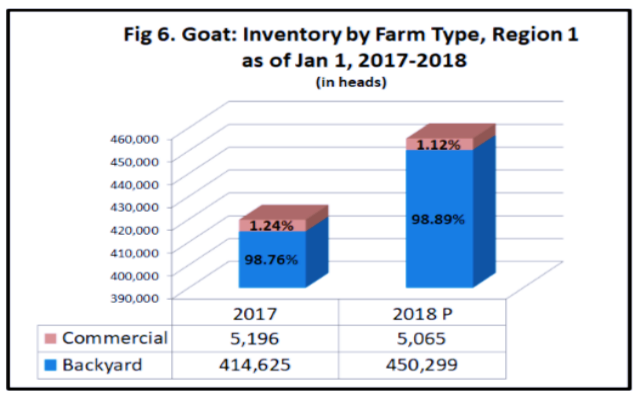
CHICKEN
Volume of chicken production at 44,478 metric tons increased by 9.07 percent in 1st semester 2018. Likewise chicken egg production was recorded at 9,140 metric tons increased by 25.64 percent over last year’s level.
Broiler, layer and native chicken posted increases in inventory at the start of 2018. The share of native chicken to the total inventory was 52.68 percent, while broiler and layer shared about 39.10 percent and 8.22 percent respectively. This can be attributed to more backyard raisers of native chicken, availability of more day-old-chicks, additional stocks and expansion of some commercial broiler and layer farms.

DUCK
The region’s duck production was 904 metric tons. This declined by 17.97 percent as compared to same period last year. Likewise, duck eggs dropped by 9.65 percent.
The backyard inventory of duck as of January 1, 2018 was 363,629 heads. This decreased by 3.36 percent as compared to same period last year. On the other hand, the inventory of duck in commercial farms increased by 75.23 percent as compared to last year’s level due to additional farms in La Union and Pangasinan. About 97.00 percent of the total duck inventory were in the backyard farms, while the remaining 3.00 percent were in the commercial farms.
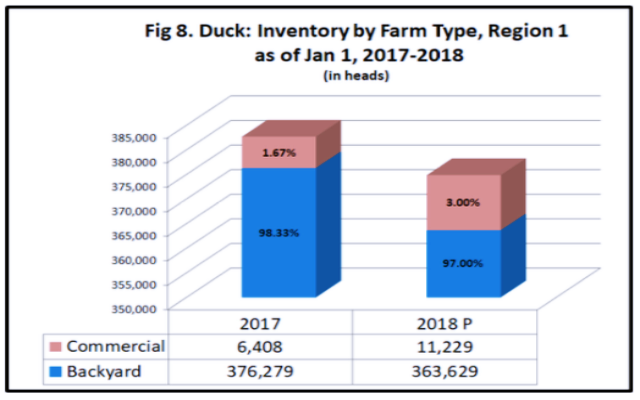
TECHNICAL NOTES
Another survey that supplements the data requirements of the sub-sector is the Compilation of Data from Slaughterhouses and Poultry Dressing Plant (CDSPDP). This covers the Accredited (AAA, AA) and Locally Registered Meat Establishments (LRMEs) nationwide and is undertaken in coordination with the National Meat Inspection Service (NMIS).
Concepts and Definitions
-
Production. Refers to the volume of indigenous (locally-raised) animals disposed for slaughter which include animals exported or shipped-out for slaughter (in “head” and in “liveweight equivalent”).
-
Livestock – farm animals kept or raised for consumption, work or leisure. In general, poultry is separated as a distinct group of farm animals. For purposes of census and surveys, livestock covers only those that are tended and raised by an operator.
-
Poultry - a collective term for all domesticated avian for the purpose of food consumption or, the carcass of such avian dressed/processed for human consumption.
-
Animal Inventory (also, Animal Population) – the number of domesticated animals in head present in the farm at specific reference date.
-
Backyard Farm/Raiser- refers to any farm or household raising at least one head of animal or bird and does not qualify as a commercial farm.
-
Commercial Livestock Farm/Operator - refers to any livestock operator or farm which operation satisfies at least one of the following conditions: a) at least 21 head of adults and zero young b) at least 41 head of young animals c) at least 10 head of adults and 22 head of young animals.
-
Commercial Poultry Farm/Operator- refers to any poultry operator or farm which operation satisfies at least one of the following conditions: a) 500 layers or 1,000 broilers b) 100 layers and 100 broilers if raised in combination c) 100 head of duck regardless of age.
-
Swine. A non-ruminant, cloven-footed animal belonging to family suidae with simple stomach, having a snout, large number of mammary glands, thin skin, and heavy bristles. It is also called hog or pig.


